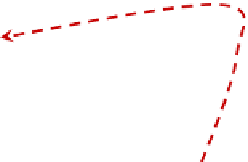Biomedical Engineering Reference
In-Depth Information
10.5.2. Metabolic Pathway Control
In Chapter 8, we learned how enzyme activity could be modulated by inhibitors or acti-
vators. Here, we discuss how the activities of a group of enzymes (a pathway) can be
controlled. The cell will attempt to make the most efficient use of its resources; the fermen-
tation specialist tries to disrupt the cell's control strategy so as to cause the cell to overpro-
duce the product of commercial interest. An understanding of how cells control their
pathways is therefore vital to the development of many bioprocesses.
First, consider the very simple case of a linear pathway making a product, P
1
. Most often
the first reaction in the pathway is inhibited by accumulation of the product ( feedback inhibi-
tion or end-product inhibition). The enzyme for the entry of substrate into the pathway would
be an allosteric enzyme (as described in Chapter 8), where the binding of the end product in
a secondary site distorts the enzyme so as to render the primary active site ineffective. Thus,
if the cell has a sufficient supply of P
1
(perhaps through an addition to the growth medium), it
will deactivate the pathway so that the substrates normally used to make P
1
can be utilized
elsewhere.
This simple concept can be extended to more complicated pathways with many branch
points (see
Fig. 10.15
). Assuming that P
1
and P
2
are both essential metabolites, the cell
may use one of several strategies to ensure adequate levels of P
1
and P
2
with efficient utili-
zation of substrates.
One strategy is the use of isofunctional enzymes (isozymes). Two separate enzymes are
made to carry out the same conversion, while each is sensitive to inhibition by a different
end product. Thus, if P
1
is added in excess in the growth medium, it inhibits one of the
(a)
Isozymes
(b)
Concerted feedback
P
1
P
1
E
4
M
4
E
4
M
4
E
2
M
2
M
1
M
3
M
1
M
2
M
3
E
3
E
3
E
2
/
E
2
E
5
E
5
M
5
M
5
P
2
P
2
(c)
Sequential feedback
(d)
Cumulative feedback
P
1
P
1
E
4
M
4
E
4
M
4
M
1
M
2
M
3
M
1
M
2
M
3
E
3
E
2
E
2
E
3
E
5
E
5
M
5
M
5
P
2
P
2
FIGURE 10.15
Examples of feedback control of branched pathways. P
1
and P
2
are the desired end products. M
1
,
M
2
,
,M
j
are intermediates, and E
j
is the enzyme involved in converting metabolite M
j
1
to M
j
possible paths of
inhibition are shown by dashed lines.
.






































Search WWH ::

Custom Search